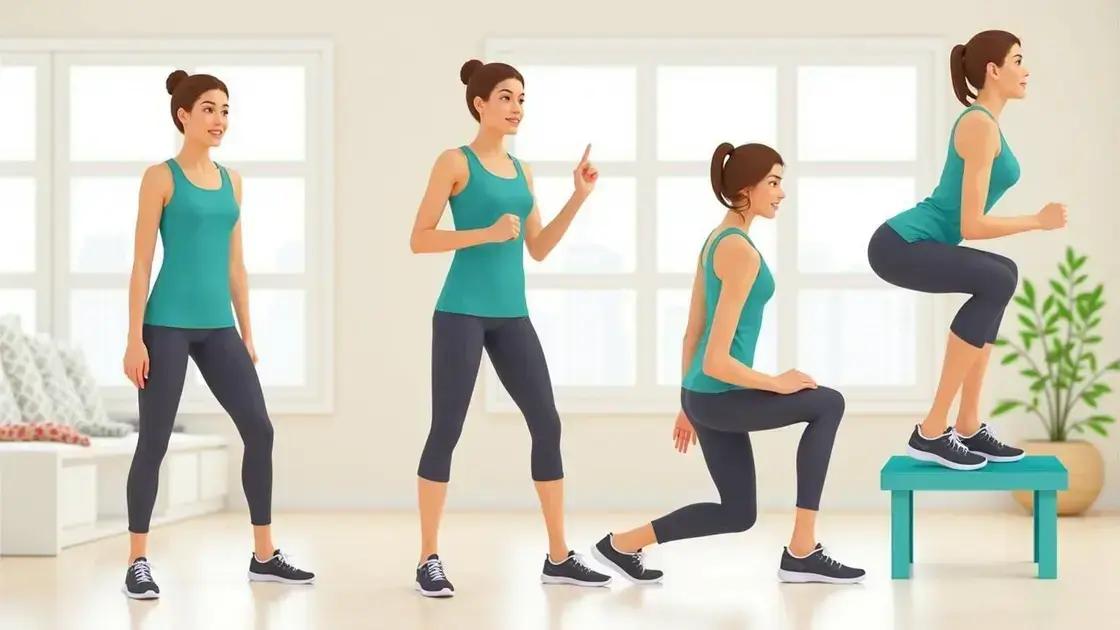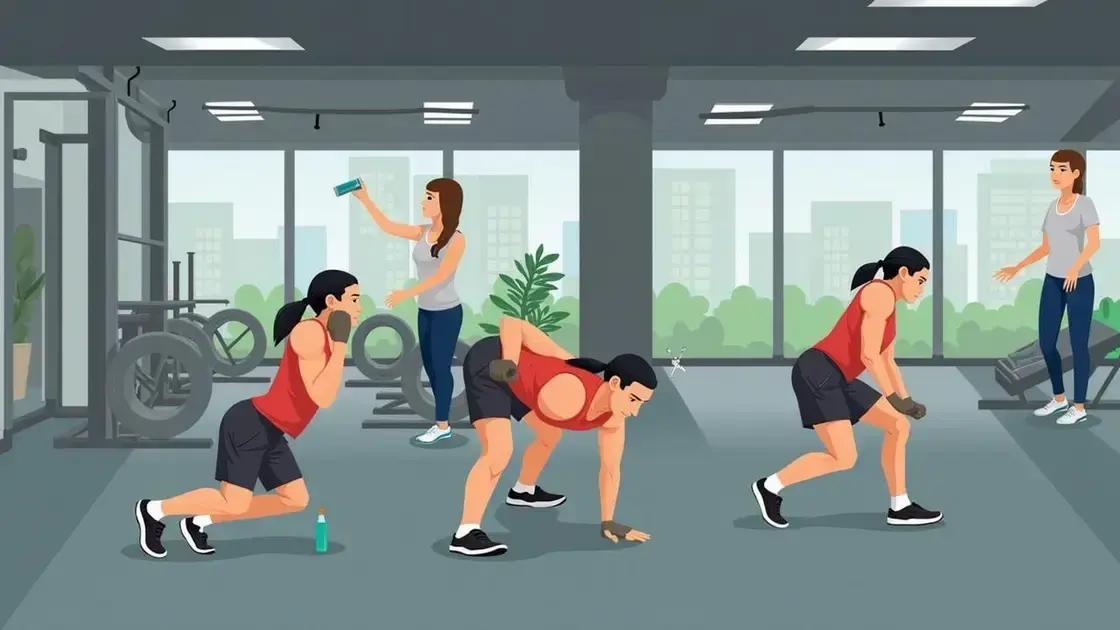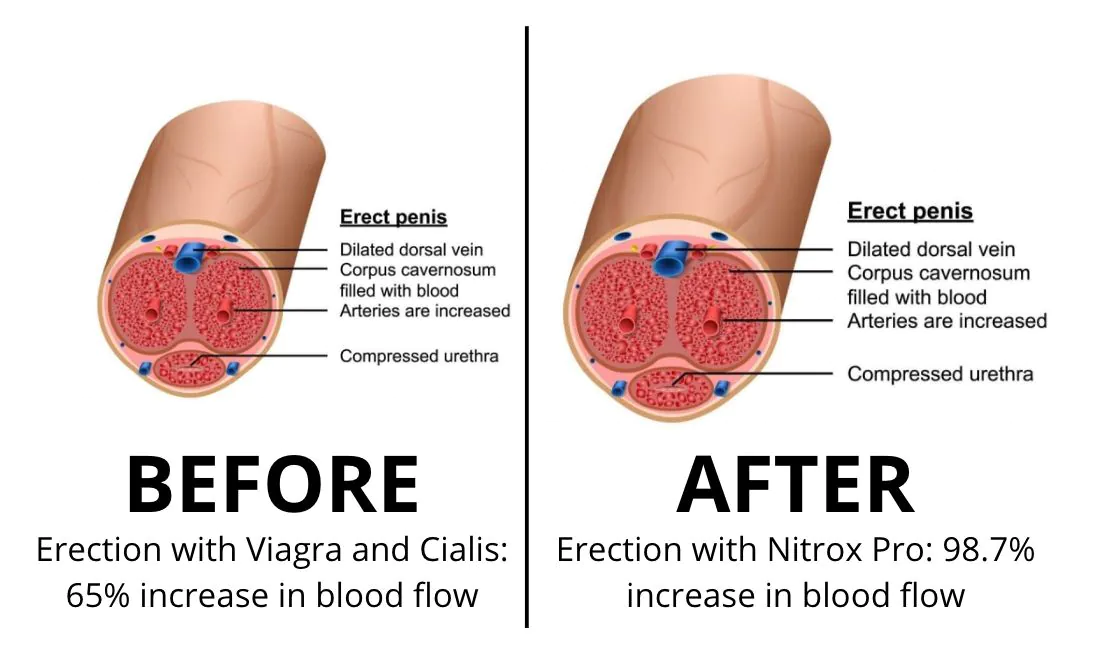Best practices for strengthening the lower body with minimal impact include exercises like bodyweight squats and glute bridges, emphasizing safety with proper form, hydration, and incorporating rest days to prevent injury while promoting strength and flexibility.
Strengthening the lower body is essential for overall fitness, especially when performed with minimal impact. This approach not only aids in developing strength but also reduces the risk of injury. In this article, we’ll explore the best practices for lower body strengthening, examine effective exercises, and provide tips to ensure your workouts are safe and productive. Whether you’re a beginner or looking to enhance your routine, our insights will guide you towards better physical health.
Understanding Lower Body Strength

Understanding lower body strength is crucial for improving overall fitness and athletic performance. The lower body consists of major muscle groups, including the quadriceps, hamstrings, calves, and glutes. Strengthening these muscles can enhance mobility, stability, and balance, all of which are important for daily activities.
Developing lower body strength provides numerous benefits. It aids in functional movements such as walking, running, jumping, and climbing stairs. Increased muscle strength in the lower body can also help prevent injuries by providing better support for your joints.
When you focus on strengthening your lower body, you should aim to engage all major muscle groups. This approach ensures a balanced physique and reduces the risk of muscular imbalances that can lead to injury.
Additionally, low-impact exercises are a fantastic way to build strength without putting excessive strain on your joints. This is especially beneficial for individuals with existing injuries or those who are just beginning their fitness journey.
In summary, understanding lower body strength lays the groundwork for effectively improving your fitness with minimal impact on your body. Incorporating strength training into your routine not only enhances physical performance but also promotes long-term health and wellness.
Benefits of Minimal Impact Training

Benefits of minimal impact training make it an ideal choice for many individuals. Unlike high-impact workouts, minimal impact training is gentle on your joints. This is particularly beneficial for people of all ages.
One of the greatest advantages is reduced risk of injury. High-intensity workouts can lead to strains and sprains, especially if proper form is not maintained. In contrast, minimal impact training helps build strength and endurance without harsh effects on the body.
Increased flexibility is another key benefit. Low-impact exercises often involve a broader range of motion, which can enhance flexibility over time. This can be particularly helpful as you age, making daily tasks easier and more enjoyable.
Moreover, minimal impact training promotes consistent exercise habits. Because it’s easier on the body, individuals are more likely to engage in regular workouts without discomfort. This can lead to improved motivation and long-term fitness success.
Another significant benefit is improved cardiovascular health. Engaging in low-impact aerobic activities supports heart health while minimizing stress on the joints. Activities like swimming, cycling, or elliptical training are excellent for this purpose.
Finally, minimal impact training can effectively target and strengthen major muscle groups, enhancing your overall physical fitness. This approach not only elevates your strength but also ensures a balanced workout routine.
Exercises for Effective Lower Body Strengthening

To effectively strengthen your lower body, it’s important to incorporate a variety of exercises that prioritize minimal impact. Here are some recommended exercises:
1. Bodyweight Squats: Stand with your feet shoulder-width apart. Lower your body by bending your knees, keeping your chest up. Go as low as comfortable, then push through your heels to stand back up.
2. Seated Leg Press: Using a leg press machine, sit and place your feet on the platform. Push the platform away by extending your legs and then return it slowly. This is great for building strength with low joint stress.
3. Glute Bridges: Lie on your back with your knees bent and feet flat on the floor. Raise your hips toward the ceiling, squeezing your glutes at the top. Lower back down and repeat.
4. Standing Calf Raises: Stand tall and slowly rise onto your toes, lifting your heels off the ground. Hold for a moment, then lower back down slowly. This exercise is great for calf strength.
5. Step-Ups: Use a low bench or step. Step onto it with one foot, driving your other knee up. Step back down and switch legs. This strengthens your quads and hamstrings while being gentle on the joints.
When performing these exercises, focus on form and control. Start with lighter resistance or body weight and increase as you build strength. The goal is to create a routine that is both effective and easy on your body.
Tips for Safe and Effective Workouts

Tips for safe and effective workouts are essential for preventing injuries and maximizing benefits. Here are some key points to keep in mind:
1. Warm Up and Cool Down: Always start your workout with a good warm-up. This can include light cardio and dynamic stretches. After your workout, cool down with gentle stretches to help your muscles recover.
2. Focus on Form: Use correct form during exercises to avoid injury. If you are unsure, consider working with a trainer or watching instructional videos. Good form also helps maximize the effectiveness of each exercise.
3. Listen to Your Body: Pay attention to how your body feels during workouts. If you experience pain or discomfort, stop and assess what might be wrong. It is better to take a break than to push through and risk injury.
4. Stay Hydrated: Drink plenty of water before, during, and after your workouts. Staying hydrated helps regulate body temperature and keep your muscles functioning properly.
5. Progress Gradually: Increase the intensity and duration of your workouts slowly. Avoid trying to do too much too soon. This is especially true for strengthening exercises, where muscle recovery time is important.
6. Include Rest Days: Allow your body time to recover between workouts. This is crucial for muscle growth and avoiding fatigue. Schedule rest days into your routine.
By following these tips, you can ensure that your lower body strengthening routine is both safe and effective, promoting overall health and fitness without excessive stress on your body.
Strengthening Your Lower Body with Minimal Impact
Incorporating minimal impact exercises into your routine can significantly enhance your lower body strength while reducing the risk of injury. By understanding the fundamentals of lower body strength, acknowledging the benefits of minimal impact training, and utilizing effective exercises, you set the foundation for a healthier, more resilient body.
Following the tips for safe and effective workouts will help you maintain a consistent routine, ensure proper technique, and promote long-term fitness success. Remember, the journey to stronger lower body muscles is a gradual process that requires patience, dedication, and mindful practices.
By embracing these best practices, you not only improve your physical capabilities but also support overall health and well-being. Start today and experience the transformative power of minimal impact workouts!
FAQ – Frequently Asked Questions about Strengthening the Lower Body with Minimal Impact
What are the benefits of minimal impact training?
Minimal impact training reduces the risk of injury, promotes flexibility, and encourages consistent workout habits while improving cardiovascular health.
What exercises can help strengthen the lower body effectively?
Effective exercises include bodyweight squats, seated leg presses, glute bridges, standing calf raises, and step-ups.
How can I ensure I’m exercising safely?
Focus on proper form, warm up and cool down, stay hydrated, and listen to your body to avoid injury during workouts.
How often should I incorporate rest days into my workout routine?
Rest days should be included regularly to allow your muscles to recover and prevent fatigue, ideally scheduling at least one or two rest days per week.
Can beginners start minimal impact lower body workouts?
Yes, minimal impact workouts are perfect for beginners as they allow for gradual strength building without excessive strain on the joints.
What should I do if I experience pain during a workout?
If you feel pain during a workout, stop immediately. Assess the situation and consult with a fitness professional or healthcare provider if needed.












